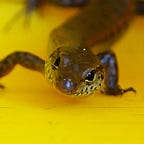Giving a Fig
The complicated relationship between figs and fig wasps
Among my collection of plants from Far North Queensland and Cape York Peninsula are two ring ins. One is Hibiscus insularis, a tree hibiscus from tiny Phillip Island a few kilometres south of Norfolk Island in the SW Pacific Ocean. The other is Ficus podocarpifolia, a scrawny scrambling fig from the red rock gorges of the Mitchell Plateau of Western Australia. The fig had a tough start in life, reduced to a leafless (and apparently lifeless) stick for months. But I kept an eye on it, watering sparingly, and it started to put out leaves again. It is doing well — so well that it has produced fruit.
Figs are strange and wonderful things. What we tend to think of as a fruit is actually a syconium, a case lined with tiny flowers. When pollinated, those flowers turn into minuscule fruit, each containing a seed. In syconia of the edible fig (F. carica), the fruit are densely packed and succulent. In many other species, they’re sparse and fibrous, and have a flavour and texture that is not for us.
With the flowers on the inside, pollination is not easy.
